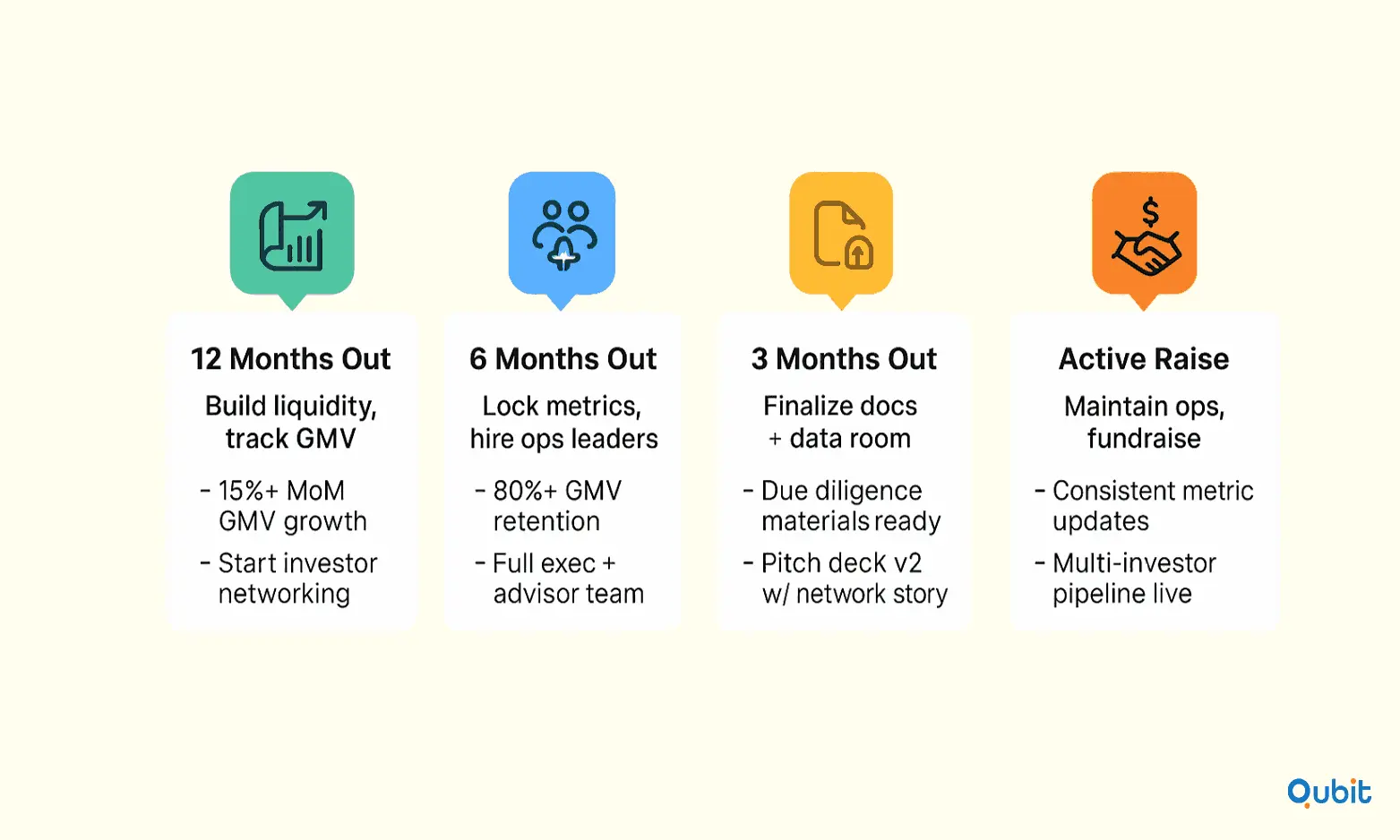Series A funding for marketplaces typically ranges from $8-15 million and represents the transition from proving concept viability to demonstrating scalable growth. However, the path to securing this institutional capital demands meticulous preparation, especially given that only 40% of seed-funded companies successfully progress to Series A. For marketplace startups, this percentage is often even lower due to the additional complexity of managing two-sided growth.
This comprehensive guide provides marketplace founders with the strategic framework, key metrics, and operational insights needed to position their companies for Series A success.
We'll explore every aspect of preparation that separates funded marketplaces from those that struggle to secure institutional capital.
What Series A Investors Seek in Marketplaces
Series A investors approach marketplace investments with heightened scrutiny around network effects and defensibility. Unlike product-focused startups where growth metrics tell a clearer story, marketplaces must demonstrate sophisticated liquidity management and prove their ability to create sustainable competitive moats through network effects.
Core Investment Criteria:
- Liquidity Achievement: Clear evidence of consistent matching between supply and demand
- Network Effects: Demonstrable improvement in user experience as the platform grows
- Market Size: Total addressable market exceeding $1 billion with clear expansion pathways
- Unit Economics: Positive contribution margins with improving efficiency at scale
- Defensibility: Barriers to entry beyond simple network effects
The Unique Challenges Marketplaces Face
Marketplace startups encounter distinct obstacles that don't affect single-sided businesses:
- The Cold Start Problem: Building initial liquidity when neither buyers nor sellers have strong incentives to join an empty platform requires sophisticated go-to-market strategies and often subsidization of one or both sides.
- Chicken-and-Egg Dynamics: Scaling supply and demand simultaneously creates resource allocation challenges that can drain runway faster than anticipated.
- Quality Control Complexities: Managing service quality across distributed supply networks while maintaining platform standards requires sophisticated operational systems.
- Competitive Moats: While network effects provide eventual defensibility, early-stage marketplaces remain vulnerable to well-funded competitors until critical mass is achieved.
Marketplace founders often underestimate the nuances in fundraising compared to consumer-focused peers. The funding guide for consumer & marketplace startups breaks down what really changes in pitch positioning and investor lens across both models.
Essential Metrics Framework for Marketplace Series A
Core Liquidity Metrics
Gross Merchandise Value (GMV)
- Target Range: $500K - $2M monthly GMV at Series A stage
- Growth Rate: 15-20% month-over-month consistency over 6+ months
- Calculation: Total transaction value flowing through the platform
GMV Retention
- Benchmark: 80%+ quarterly GMV retention from existing users
- Significance: Demonstrates platform stickiness and repeat engagement
- Investor Focus: Shows sustainable growth beyond one-time transactions
Take Rate
- Typical Range: 8-15% for services, 3-8% for goods marketplaces
- Trend: Should show stability or improvement over time
- Context: Must be analyzed alongside competitive positioning
Supply and Demand Balance Metrics
| Metric | Definition | Series A Target | Why It Matters |
|---|---|---|---|
| Liquidity Score | Successfully matched transactions ÷ Total attempted matches | >60% | Core platform functionality |
| Search-to-Fill Rate | Successful purchases ÷ Search attempts | >25% | Demand satisfaction efficiency |
| Sell-Through Rate | Items sold ÷ Items listed | >40% | Supply-side satisfaction |
| Time to First Transaction | Average time for new users to complete first transaction | <7 days | User activation speed |
| Buyer-to-Seller Ratio | Active buyers ÷ Active sellers | 3:1 to 10:1 | Platform balance indicator |
Financial Performance Indicators
Customer Acquisition Cost (CAC) by Side
- Buyer CAC: Should trend downward with scale
- Seller CAC: Often higher initially but crucial for supply density
- Blended CAC: Total acquisition cost across both sides
- Benchmark: CAC payback period under 12 months
Customer Lifetime Value (LTV)
- Buyer LTV: Revenue generated over customer relationship
- Seller LTV: Fees collected from supply-side participants
- Target Ratio: LTV:CAC ratio of 3:1 minimum, ideally 4:1+
Unit Economics Health
- Contribution Margin: Revenue per transaction minus variable costs
- Path to Profitability: Clear timeline to positive unit economics
- Margin Expansion: Evidence that margins improve with scale
Building Your Series A-Ready Team Structure
Executive Team Requirements
Chief Executive Officer (CEO)
Series A investors expect marketplace CEOs to demonstrate strategic vision for two-sided growth alongside operational excellence. The ideal marketplace CEO combines:
- Prior experience managing complex, multi-stakeholder businesses
- Deep understanding of network effects and platform dynamics
- Proven ability to manage resource allocation between competing priorities
- Strong fundraising track record and investor relations skills
Chief Technology Officer (CTO)
Technology infrastructure becomes critical as marketplaces scale. Your CTO should have:
- Experience building scalable, two-sided platforms
- Understanding of search, matching, and recommendation algorithms
- Expertise in payment processing and marketplace-specific technical challenges
- Team leadership experience for growing engineering organizations
Head of Operations/Marketplace Operations
This role is uniquely critical for marketplaces and often underestimated:
- Experience managing supply quality and seller onboarding
- Understanding of fraud prevention and trust & safety systems
- Ability to design and optimize matching algorithms and processes
- Skills in community management and dispute resolution
Advisory Board Composition
Strategic advisors become particularly valuable for marketplace Series A preparation:
- Industry Veterans: Advisors from successful marketplaces (Airbnb, Uber, Etsy alumni) provide credibility and tactical insights.
- Functional Experts: Growth marketing, operations, and product specialists with marketplace experience.
- Potential Customers: Representatives from both supply and demand sides who can validate product-market fit.
- Regulatory Experts: Advisors who understand compliance requirements in your vertical.
When recurring revenue is strong and equity is costly, venture debt solutions for consumer tech startups can extend your runway without giving up board seats.
Operational Excellence: Systems and Processes
Quality Management Systems
Supply-Side Quality Control
- Automated screening and onboarding processes for new suppliers
- Performance monitoring and rating systems
- Intervention protocols for quality issues
- Supplier education and improvement programs
Demand-Side Experience Optimization
- Search and discovery algorithm performance
- Customer service response time benchmarks
- Dispute resolution processes and outcomes
- User feedback integration systems
Trust and Safety Infrastructure
Fraud Prevention
- Identity verification systems for both sides
- Payment security and chargeback management
- Suspicious activity detection algorithms
- Insurance or guarantee programs where applicable
Community Standards
- Clear terms of service and community guidelines
- Proactive content and behavior moderation
- Appeal and resolution processes
- Transparency reports and policy updates
Not every D2C or marketplace startup should chase scale the same way, and this breakdown of scaling capital for marketplaces & d2c brands helps define why.
Addressing Marketplace-Specific Investor Concerns
Network Effects Validation
Demonstrating Network Value
Investors need evidence that your platform becomes more valuable as it grows:
- User Experience Improvements: Show how additional supply/demand improves matching quality
- Pricing Power: Evidence that scale allows for better pricing or take rates
- Competitive Advantages: Clear barriers competitors face when entering your market
Scalability Proof Points
Geographic Expansion
- Successful launch in multiple markets with consistent performance
- Playbook for entering new geographies efficiently
- Local adaptation strategies while maintaining core value proposition
Vertical Expansion
- Ability to extend platform to adjacent categories or services
- Cross-selling success between different marketplace verticals
- Platform infrastructure that supports multiple use cases
Competitive Differentiation
Sustainable Advantages Beyond Network Effects
- Proprietary technology or algorithms
- Exclusive supplier relationships or inventory access
- Regulatory advantages or compliance expertise
- Brand strength and consumer trust
Pre-Fundraising Preparation (3-6 Months Before)
Financial Documentation
- Monthly cohort analyses showing GMV and revenue trends
- Detailed unit economics with marketplace-specific metrics
- Cash flow projections incorporating two-sided growth investments
- Scenario planning for different growth and funding strategies
Strategic Positioning
- Competitive landscape analysis with positioning rationale
- Total addressable market sizing with bottoms-up validation
- Go-to-market evolution from current state to Series B readiness
- International expansion strategy and timeline
Due Diligence Preparation
Marketplace-Specific Data Rooms
Beyond standard startup documentation, marketplaces need:
- Liquidity Analytics: Historical matching rates, search success metrics, time-to-transaction data
- Supplier Analysis: Concentration risk, supplier lifetime value, churn analysis by tier
- Customer Segmentation: Behavior patterns, repeat usage, cross-category engagement
- Operational Metrics: Customer service response times, dispute resolution outcomes, fraud rates
Reference Preparation
- Key suppliers willing to speak about platform value
- High-value customers who can validate demand-side experience
- Former employees who can speak to culture and execution
- Industry experts who can validate market position
When brand velocity outpaces your burn rate, aligning with the right growth-equity options for d2c brand expansion becomes more about timing than dilution.
Pitch Deck Essentials for Marketplaces
The Marketplace-Specific Slide Structure:
- Problem & Solution: Focus on friction in existing market transactions
- Market Opportunity: Two-sided market sizing with growth projections
- Product Demo: Show the matching process and user experience
- Network Effects: Evidence of platform value improving with scale
- Traction: Liquidity metrics, growth rates, and user satisfaction
- Business Model: Take rates, unit economics, and path to profitability
- Go-to-Market: Strategy for scaling both supply and demand
- Competition: Differentiation and defensive moats
- Team: Marketplace-specific experience and expertise
- Financials: Revenue projections with marketplace metric drivers
- Funding Use: Specific allocation between supply/demand acquisition
- Vision: Path to market leadership and eventual exit opportunities
Common Pitfalls and Strategic Solutions
Financial Planning Mistakes
Underestimating Dual-Side CAC
Many marketplace founders focus primarily on demand-side acquisition costs while underestimating supply acquisition expenses. This leads to:
- Solution: Develop separate CAC and LTV models for each side
- Benchmark: Plan for 60-70% of early funding going to user acquisition
- Strategy: Build CAC payback models that account for cross-side network effects
Ignoring Contribution Margin Timing
Marketplaces often achieve positive gross margins before positive contribution margins due to customer service, fraud, and operational costs.
- Solution: Track full-loaded contribution margins including all variable costs
- Timeline: Plan for 12-18 months to achieve positive unit economics at scale
- Investor Communication: Be transparent about margin expansion timeline
Operational Scaling Challenges
Quality Control at Scale
Maintaining service quality while rapidly expanding supply creates operational strain.
Strategic Approach:
- Implement automated quality scoring systems early
- Develop supplier tiering with different service level requirements
- Build community-driven rating and feedback systems
- Invest in customer service and dispute resolution infrastructure
Geographic Expansion Timing
Expanding to new markets too quickly can dilute network effects and strain operations.
Best Practices:
- Achieve strong unit economics in initial markets before expanding
- Develop standardized launch playbooks with local adaptation capabilities
- Ensure operational systems can handle multi-market complexity
- Plan for 3-6 months per new major market launch
Team and Culture Considerations
Balancing Supply and Demand Focus
Marketplace teams often develop bias toward one side of the platform.
Organizational Solutions:
- Establish separate but coordinated supply and demand teams
- Implement metrics that reward balanced growth over pure volume
- Create cross-functional alignment through shared liquidity goals
- Ensure executive team has experience managing two-sided dynamics
Timeline and Preparation Checklist

12 Months Before Series A
Foundation Building:
- Achieve consistent monthly GMV growth of 15%+ for 3+ consecutive months
- Implement comprehensive marketplace metrics tracking across all key areas
- Build supply and demand acquisition playbooks with measurable CAC
- Establish quality management and trust & safety systems
- Begin building relationships with target Series A investors
6 Months Before Series A
Metrics and Team Readiness:
- Demonstrate 80%+ GMV retention and improving unit economics
- Complete executive team with marketplace-experienced leadership
- Build comprehensive financial model with marketplace-specific drivers
- Establish advisory board with relevant industry expertise
- Begin competitive intelligence and market positioning analysis
3 Months Before Series A
Fundraising Preparation:
- Complete due diligence data room with marketplace-specific documentation
- Finalize pitch deck with compelling network effects story
- Secure customer and supplier references for investor calls
- Develop detailed use of funds plan with growth milestone targets
- Begin investor outreach through warm introductions and network connections
Understanding buyer psychology is just one piece of evaluating the landscape, something the investor’s guide to consumer & d2c startups puts in investor-first context.
Active Fundraising Period
Execution Excellence:
- Maintain consistent performance metrics throughout fundraising process
- Provide regular investor updates showing continued growth and progress
- Manage multiple investor relationships while maintaining operational focus
- Negotiate term sheets with marketplace-specific considerations
- Plan post-funding scaling strategy and immediate next steps
Conclusion: Your Path to Series A Success
Preparing for Series A funding as a marketplace startup requires a sophisticated understanding of two-sided platform dynamics, investor expectations, and operational complexity that goes far beyond traditional startup fundraising. The marketplaces that successfully secure Series A funding are those that demonstrate mastery of liquidity creation, sustainable unit economics, and defensible network.
Tired of your numbers getting the “meh” treatment? Explore our Financial Model Creation service to make your numbers airtight.
Key Takeaways
- Marketplace startups need $500K-$2M monthly GMV with 15-20% month-over-month growth and 80%+ GMV retention to be Series A ready, demonstrating successful two-sided platform liquidity.
- Series A investors expect marketplace-specific metrics like liquidity scores above 60%, search-to-fill rates over 25%, and LTV:CAC ratios of 3:1+ with clear unit economics improvement at scale.
- Executive teams must include marketplace-experienced leadership in operations roles, as managing supply quality, trust & safety, and two-sided growth requires specialized expertise beyond typical startup skills.
- Successful Series A preparation takes 12+ months, requiring simultaneous scaling of supply and demand sides while building operational systems for quality control, fraud prevention, and customer service.
- Network effects validation is crucial - investors need evidence that platform value increases with scale through improved matching quality, pricing power, and competitive advantages beyond simple user growth.
Frequently asked Questions
What GMV and growth metrics do Series A investors expect from marketplace startups?
Series A investors typically look for $500K-$2M in monthly GMV with consistent 15-20% month-over-month growth over 6+ months. You also need to demonstrate 80%+ quarterly GMV retention and a clear path to positive unit economics.






